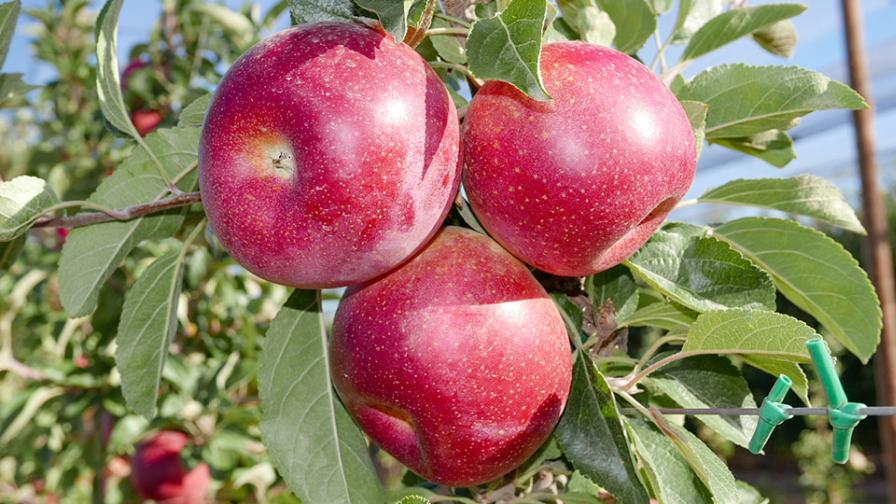New Zealand and Spain Release First ‘Hot-Climate’ Apple

In response to concern about climate change, New Zealand Plant & Food Research has worked with apple researchers and growers in the Catalonia Province of Spain in releasing the first hot-climate apple, ‘HOT84A1’, which will receive a brand name before it hits the market.
Photo courtesy of Plant & Food Research
Growers around the world have been increasingly concerned about climate change — whether unseasonably cold winters or untimely warm springs — and in response, New Zealand Plant & Food Research has worked with apple researchers and growers in the Catalonia Province of Spain in releasing the first hot-climate apple.
‘HOT8A41’, which will receive a brand name before it hits the market, is the first release from the New Zealand-Spain collaborative Hot Climate Programme (HCP), Richard Volz, New Zealand Plant & Food Research (PFR) Science Team Leader, says. The naming will be handled by T&G Global, managed through its VentureFruit business, which is the strategic commercialization partner for the HCP, which is owned by PFR, the Catalan Institute of AgriFood Research and Technology (IRTA) and the Catalan grower group, Fruit Futur.
The new apple’s parents include two New Zealand varieties that may be familiar to U.S. growers: ‘Scilate’, which is familiarly known as ‘Envy’, and ‘Scired’, a sibling of ‘Pacific Rose’, which is marketed in New Zealand as ‘Pacific Queen’ or ‘New Zealand Queen’.
Like most varieties, these two parents were bred or selected for the more temperate growing regions of the world, as is New Zealand for the most part, Volz says. This fact has long concerned Volz and his colleagues, who saw such varieties as ‘Gala’ and ‘Golden Delicious’ widely planted in warmer areas, such as Catalonia.
“Even in the early 2000s, we realized there might be some benefit to have varieties already adapted to hot growing conditions,” he says. “An apple has to be adapted to the conditions it’s growing in.”
HOT AND COLD
Volz explains that apples and pears are generally reasonably well adapted to changing temperatures, as long as they get winter chilling for good flowering. But to get the level of high quality today that consumers demand, it has to be adapted to that environment. For example, South Africa, which has a good history of growing apples and pears, is also facing problems because of warming temperatures.
“We want to ensure the apples will grow even if the temperatures get hotter than they are today,” he says. “Where the modeling is showing winter chilling could be an issue, it would be advantageous to have a breeding station in that location. One of best ways to breed for a new environment is to place materials in that environment.”
However, Volz says in Catalonia, the issue is the very hot climate during the growing season, as chilling is no problem there. In addition, the growers in the region are determined to continue their successful industry because they have a lot of other factors in their favor.
“In terms of water resources, good soils, an established industry, and knowledgeable, experienced growers, they have everything else going for them,” he says.
TEMPERATE REGIONS
It’s believed that ‘HOT8A41’ won’t be limited to warmer climates. Preliminary testing at several locations in Northern Europe have been promising, though Volz cautions that the testing has been limited. (No test blocks have been planted in the U.S. as of yet, he says, but they are coming.) But the results don’t surprise him.
“We often see that apples selected in cool climates have reduced quality, such as poor red coloration and softer textures, when grown under warm climates. But to date we have not seen any problems when selection of an apple occurs under hot growing conditions, but they are grown in cooler conditions. Apples aren’t the only pome crop under study, as Volz says a good number of pears are being tested. Both European and Asian pear types are being evaluated in Spain as well as Northern Europe, and Volz says there will also be test blocks planted in the U.S. in the future.
The next phase of development, Volz says, is to bring in disease resistance, and in some cases, pest resistance.
“It’s where we need to go, particularly in Europe. We need to respond to consumers who want lower chemical inputs,” he says. “Also, there are stricter government regulations in the EU, but it’s a worldwide trend.”
This research will benefit growers as well as researchers, Volz says, as there are other pressures at work on growers. Breeding, not chemical inputs, needs to shoulder more of the load.
“Relying on chemistry is becoming more difficult, as fewer chemicals are being produced for disease control,” he says.









